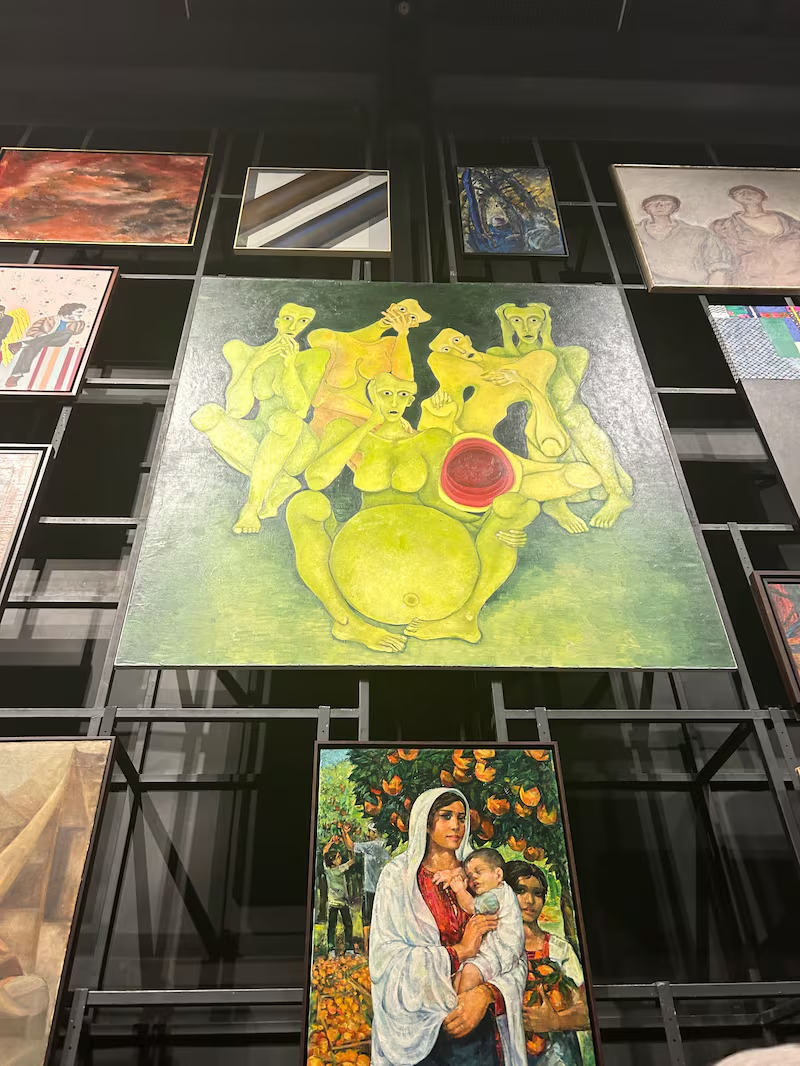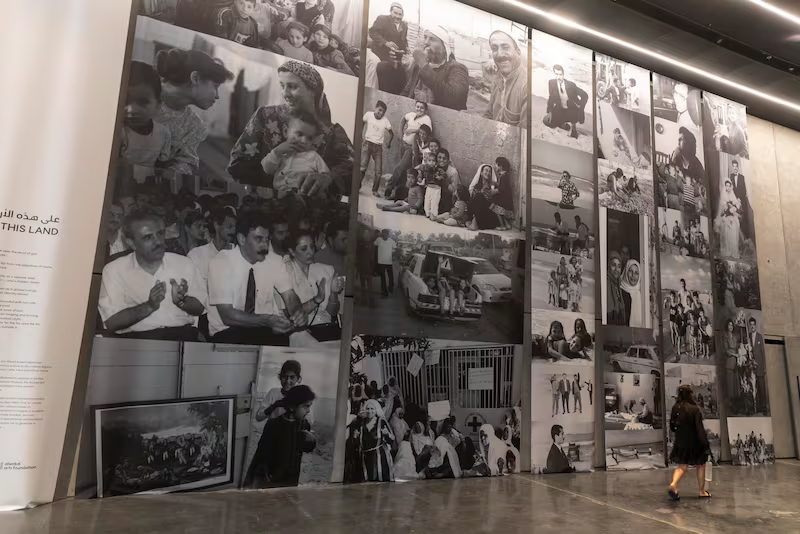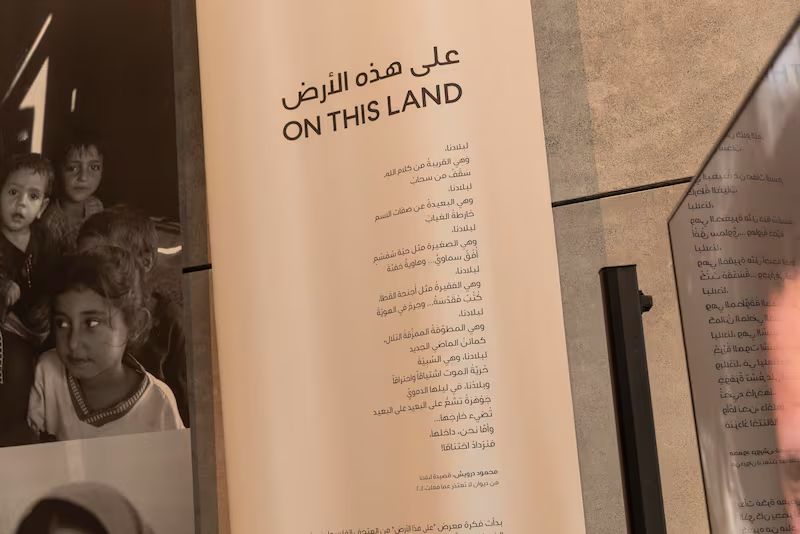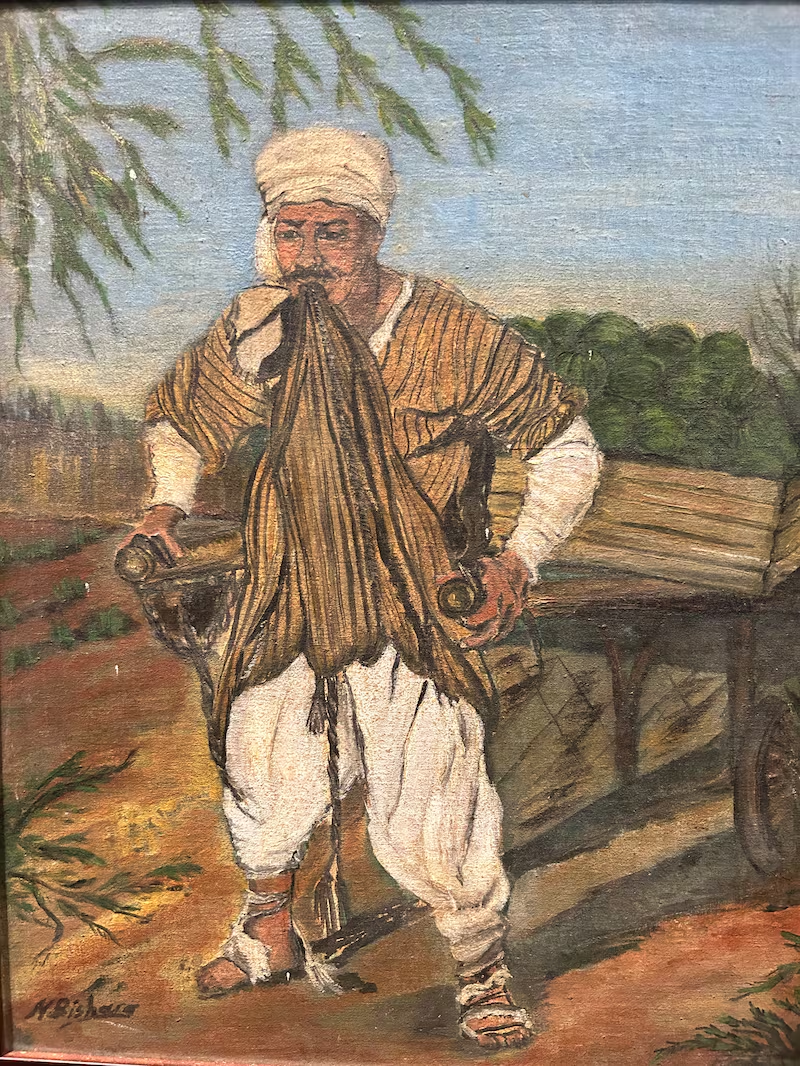AUTHOR: RAZMIG BEDIRIAN
The show, which comes as a response to the Israel-Gaza war, is running at Concrete until Sunday.
At On This Land, a new exhibition at Concrete in Alserkal Avenue, Layan Shawabkeh’s Ladies of Gaza stands out – even on a wall tiled with masterpieces.
The painting takes cues from Pablo Picasso’s 1907 work Les Demoiselles d’Avignon by depicting five women. However, that is where the similarities end. The women in Shawabkeh’s painting are depicted in a sallow green that radiates from the subdued background. Seated with their knees up, their joints bulbously emerge against their malnourished frames. Their expressions are harrowing. Their eyes are wide and their mouths agape with distress. The woman in the centre is pregnant. The one on her left used to be, her belly plainly cored out.

Ladies of Gaza was painted in 2009, the year Shawabkeh died at the age of 23 following a battle with cancer. Today, the painting is a potent reminder of the continuing horror Palestinians in Gaza are facing against Israeli onslaught.
“Ladies of Gaza is centre stage, the heart of the exhibition,” says Sultan Al Qassemi, founder of Barjeel Art Foundation, which is one of the three institutions behind On This Land, along with The Palestinian Museum and Alserkal Arts Foundation.
“[Shawabkeh] studied Les Demoiselles d’Avignon, but she reclaimed it to being a depiction of the horrors women of Gaza are experiencing,” Al Qassemi says. “She studied the faces of women in Palestine and Iraq and in other conflict to depict the horrors. These are women who have either lost their kids or are pregnant with kids to come. It is about the past and the future.”

While Ladies of Gaza is a visceral reflection of the Palestinian struggle, On This Land also aims to honour the culture that is at risk of erasure by the Israeli offensive. The exhibition, which runs until Sunday, brings together 100 artworks, including paintings, sculptures and digital works, alongside a large collection of archival photographs. The title of the exhibition, meanwhile, is drawn from a poem by Mahmoud Darwish.
“The theme is Palestine,” Al Qassemi says. “There are abstract works, mixed with figurative works. There are works with textile in them, like those of Dia Azzawi and Naim Ismail. You have Syrian, Iraqi, Saudi, Jordanian, Emirati, Algerian artists, artists from all around the Arab world, expressing their solidarity with Palestine.”

Many of these artworks reflect on the injustices Palestinians are facing, whereas others depict life outside the conflict, particularly the archival photographs. Printed on vertical fabrics hanging around the space, they come from the collection of The Palestinian Museum. They show classrooms, conferences, street vendors and family portraits from across Palestine. There are also photographs that show protests against Israeli occupation.
“Today there is a pressing question, ‘how big is Palestine? What’s the total area of Palestine?’” Amer Shomali, general director of the museum, said in a video statement at the exhibition’s opening on Sunday. “Events like this one, and collaborations like the one we are witnessing today, reveal that Palestine spans over the whole world.”
Shomali also touched upon the exhibition that The Palestinian Museum had been preparing in honour of the legacy of Gaza, saying it had to be pulled down as the conflict broke out.
“Starting October 8, The Palestinian Museum has been closed. Reaching the museum became dangerous. We dismantled the exhibition and we secured all the artworks inside and outside the museum in anticipation of an army or settler’s raid. We can’t risk getting looted.
“Despite closing the museum’s door, other doors opened and new spaces emerged, like this one. When exhibiting in Palestine becomes impossible because of the war, new platforms embrace us. When our voices get silenced and censored, you become our voices. Today, our priority [is] to amplify that voice and demand an end to the genocide.”

On This Land, itself, has come about as a quick response to the Israel-Gaza war. The space was being prepared for another show, but as the conflict intensified, Alserkal Arts Foundation partnered with The Palestinian Museum and the Barjeel Art Foundation to put together the new exhibition. It was assembled at breakneck speed, manifesting within two weeks.
“We had our usual plans for Alserkal Art Week as we do every year and then you cannot continue your normal life when something not normal at all is happening in our region, and to our friends and families,” Zaina Zaarour, programmes manager at Alserkal Arts Foundation, says.
“This made a lot of sense, and thanks to our partners who jumped right in and were very generous, we pulled it off in 12 days, and it was actually just two days of installing.”
The curation of On This Land also has a significant message. With internal walls that slide and rotate, Concrete is a space that allows for almost a dozen configurations. For the exhibition, the central walls have been arranged into a U-shape, with the barred grid facing outward.
“We tried different configurations,” Suheyla Takesh, curator of Barjeel Art Foundation, says. “The other sides are cladded with gypsum board, but we wanted the grid to face outward to create this cage, or prison.”
Zaarour expands on the aesthetic motives behind the decision, saying the artworks displayed on top of the grid gave them the sensation of breaking out of the barred confines. She also touched upon the reasons for not labelling each artwork on site, instead prompting visitors to scan a bar code to find out more about the pieces.
“These works speak for themselves,” she says. “We’re also encouraging conversation. We have daily tours for the exhibition. We are encouraging people to come, ask questions and research these artists.”
On This Land is replete with artworks that are landmarks of Arab art, making the exhibition significant even when viewed outside of the lens of the current conflict. The works span more than 70 years.

These include an untitled 1946 painting by Jabra Ibrahim Jabra, which depicts three sombre figures painted with oil on jute fibre. Works from the Sabra Shatila etching series by Azzawi, meanwhile, are also on display. The etchings, produced in 1983, were a response to the 1982 massacres of Palestinian refugees and civilians in Beirut during the Lebanese Civil War.
Raafat Ballan’s 2021 painting The City Before it was Transformed is a tribute to a Gaza before besiegement by Israel. The work shows a group of people across two tables, drinking tea and conversing merrily. Emirati artist Abdul Qader Al Rais’s Waiting is a 1970 canvas that evokes the melancholy and struggle of Palestinian children. Faten Alfred Tubasi’s 1984 Heroic Act, a recent acquisition by Barjeel Art Foundation, is dedicated to Lina Al Nabulsi, 15, who led a protest with fellow students of Aishiya School on the 28th anniversary of the Nakba. She was murdered days later by an Israeli soldier.
“The work was really lost for 40 years,” Al Qassemi says. “We just received it a few weeks ago. This is the first time it is being seen in public for almost 40 years. It needs a little bit of restoration. But we thought ‘let’s just show it’ because this is the time for it to be seen.”

Another key work is Nahil Bishara’s Watermelon Farmer, a 1956 painting that depicts a man pulling a cart of watermelons. The fruit has since become a symbol of Palestinian resistance and solidarity.
Bishara’s granddaughter, Talia Bishara, was present during the opening of On This Land. The painting, she points out, was created a mere eight years after the Nakba. “My grandmother was born in 1919 and passed away in 1997,” Bishara says. “She passed away in Jerusalem. I personally had to leave that house in 2002 during the Second Intifada. All that I took with me where her belongings and her beautiful artworks.”
“The Watermelon Farmer captures the hardships of Palestinian farmers at the time,” she says. “You can also notice their traditional attire of the time. But more importantly, it captures the resilience, tenacity and the endurance of the Palestinian society, but also shows how fertile the Palestinian soil is.”
The significance of On This Land was clear during opening night, as crowds flocked into Concrete to take in the artworks and show their solidarity with those in Palestine. Among the attendants was George Al Ama, a renowned academic and collector of Palestinian art. Al Ama says the exhibition is the largest presentation of Palestinian art that he has ever seen.
“It’s most likely that this is the largest collection of Palestinian art in one place,” he says. “It stretches from modern works to contemporary works. You see the names of titanic artists, such as Ismail Shammout, pioneers like Nahil Bishara, Larissa Sansour and Ahmad Canaan. You see works from the following generation. You see it all at once. During these difficult political times, for me is more than a feast for the eyes. It is a triumph for Palestinian culture.”
This article was originally published in The National on November 20, 2023. A PDF screenshot of the original article can be downloaded here.